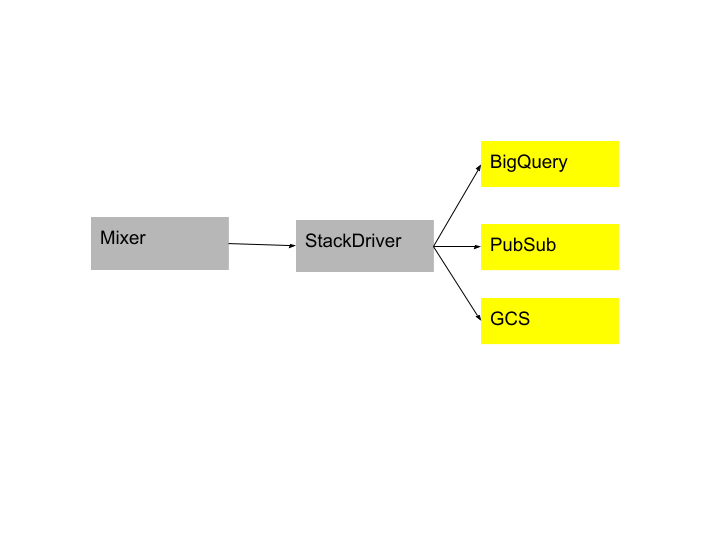通過 Stackdriver 將日誌匯出至 BigQuery、GCS、Pub/Sub
如何通過 Stackdriver 將 Istio 存取日誌匯出至不同的接收器,如 BigQuery、GCS、Pub/Sub。
這篇文章說明如何將 Istio 日誌導向 Stackdriver,並將這些日誌匯出至各種配置的接收器,例如 BigQuery、Google Cloud Storage 或 Cloud Pub/Sub。在這篇文章結束後,您可以從您喜歡的地方(例如 BigQuery、GCS 或 Cloud Pub/Sub)對 Istio 數據執行分析。
整個任務中使用 Bookinfo 範例應用程式作為範例。
開始之前
在您的叢集中安裝 Istio 並部署應用程式。
配置 Istio 以匯出日誌
Istio 使用 logentry 範本匯出日誌。這指定所有可用於分析的變數。它包含來源服務、目的地服務、身份驗證指標(即將推出)等資訊。以下是管線的示意圖
Istio 支援將日誌匯出到 Stackdriver,然後可以配置 Stackdriver 將日誌匯出到您喜歡的接收器,例如 BigQuery、Pub/Sub 或 GCS。請按照以下步驟設定您喜歡的接收器以先匯出日誌,然後在 Istio 中設定 Stackdriver。
設定各種日誌接收器
所有接收器的通用設定
- 為專案啟用 Stackdriver Monitoring API。
- 確保設定接收器的
principalEmail具有專案的寫入權限和 Logging Admin 角色權限。 - 確保已設定
GOOGLE_APPLICATION_CREDENTIALS環境變數。請按照 這裡 的說明進行設定。
BigQuery
- 建立 BigQuery 資料集作為日誌匯出的目的地。
- 記錄資料集的 ID。它將用於配置 Stackdriver 處理器。它將採用
bigquery.googleapis.com/projects/[PROJECT_ID]/datasets/[DATASET_ID]的形式 - 在 IAM 中,給予 接收器的寫入者身份:
cloud-logs@system.gserviceaccount.comBigQuery 資料編輯者角色。 - 如果使用 Google Kubernetes Engine,請確保在叢集上啟用
bigquery範圍。
Google Cloud Storage (GCS)
- 建立 GCS 儲存貯體,您希望將日誌匯出到 GCS。
- 記錄儲存貯體的 ID。它將用於配置 Stackdriver。它將採用
storage.googleapis.com/[BUCKET_ID]的形式 - 在 IAM 中,給予 接收器的寫入者身份:
cloud-logs@system.gserviceaccount.comStorage Object Creator 角色。
Google Cloud Pub/Sub
- 建立主題,您希望將日誌匯出到 Google Cloud Pub/Sub。
- 記錄主題的 ID。它將用於配置 Stackdriver。它將採用
pubsub.googleapis.com/projects/[PROJECT_ID]/topics/[TOPIC_ID]的形式 - 在 IAM 中,給予 接收器的寫入者身份:
cloud-logs@system.gserviceaccount.comPub/Sub Publisher 角色。 - 如果使用 Google Kubernetes Engine,請確保在叢集上啟用
pubsub範圍。
設定 Stackdriver
必須建立 Stackdriver 處理器才能將資料匯出到 Stackdriver。有關 Stackdriver 處理器的配置說明,請參閱 這裡。
將以下 yaml 檔案儲存為
stackdriver.yaml。將<project_id>、<sink_id>、<sink_destination>、<log_filter>替換為其特定值。apiVersion: "config.istio.io/v1alpha2" kind: stackdriver metadata: name: handler namespace: istio-system spec: # We'll use the default value from the adapter, once per minute, so we don't need to supply a value. # pushInterval: 1m # Must be supplied for the Stackdriver adapter to work project_id: "<project_id>" # One of the following must be set; the preferred method is `appCredentials`, which corresponds to # Google Application Default Credentials. # If none is provided we default to app credentials. # appCredentials: # apiKey: # serviceAccountPath: # Describes how to map Istio logs into Stackdriver. logInfo: accesslog.logentry.istio-system: payloadTemplate: '{{or (.sourceIp) "-"}} - {{or (.sourceUser) "-"}} [{{or (.timestamp.Format "02/Jan/2006:15:04:05 -0700") "-"}}] "{{or (.method) "-"}} {{or (.url) "-"}} {{or (.protocol) "-"}}" {{or (.responseCode) "-"}} {{or (.responseSize) "-"}}' httpMapping: url: url status: responseCode requestSize: requestSize responseSize: responseSize latency: latency localIp: sourceIp remoteIp: destinationIp method: method userAgent: userAgent referer: referer labelNames: - sourceIp - destinationIp - sourceService - sourceUser - sourceNamespace - destinationIp - destinationService - destinationNamespace - apiClaims - apiKey - protocol - method - url - responseCode - responseSize - requestSize - latency - connectionMtls - userAgent - responseTimestamp - receivedBytes - sentBytes - referer sinkInfo: id: '<sink_id>' destination: '<sink_destination>' filter: '<log_filter>' --- apiVersion: "config.istio.io/v1alpha2" kind: rule metadata: name: stackdriver namespace: istio-system spec: match: "true" # If omitted match is true. actions: - handler: handler.stackdriver instances: - accesslog.logentry ---推送配置
$ kubectl apply -f stackdriver.yaml stackdriver "handler" created rule "stackdriver" created logentry "stackdriverglobalmr" created metric "stackdriverrequestcount" created metric "stackdriverrequestduration" created metric "stackdriverrequestsize" created metric "stackdriverresponsesize" created將流量傳送到範例應用程式。
對於 Bookinfo 範例,請在您的網頁瀏覽器中瀏覽
http://$GATEWAY_URL/productpage,或發出以下命令$ curl http://$GATEWAY_URL/productpage驗證日誌是否正在通過 Stackdriver 流向已配置的接收器。
- Stackdriver:導覽至您專案的 Stackdriver Logs Viewer,並在「GKE Container」->「叢集名稱」->「命名空間 ID」下尋找 Istio 存取日誌。
- BigQuery:導覽至您專案的 BigQuery 介面,您應該會在您的接收器資料集中找到一個帶有字首
accesslog_logentry_istio的表格。 - GCS:導覽至您專案的 Storage Browser,您應該會在您的接收器儲存貯體中找到一個名為
accesslog.logentry.istio-system的儲存貯體。 - Pub/Sub:導覽至您專案的 Pub/Sub 主題清單,您應該會在您的接收器主題中找到一個
accesslog的主題。
了解發生了什麼
上面的 Stackdriver.yaml 檔案配置了 Istio 將存取日誌傳送到 Stackdriver,然後新增了一個接收器配置,以便可以匯出這些日誌。詳細資訊如下
新增了一個
stackdriver類型的處理器apiVersion: "config.istio.io/v1alpha2" kind: stackdriver metadata: name: handler namespace: <your defined namespace>在 spec 中新增了
logInfospec: logInfo: accesslog.logentry.istio-system: labelNames: - sourceIp - destinationIp ... ... sinkInfo: id: '<sink_id>' destination: '<sink_destination>' filter: '<log_filter>'在以上配置中,sinkInfo 包含有關您希望將日誌匯出到的接收器的資訊。有關如何為不同的接收器填寫此資訊的更多資訊,請參閱 這裡。
新增了 Stackdriver 的規則
apiVersion: "config.istio.io/v1alpha2" kind: rule metadata: name: stackdriver namespace: istio-system spec: match: "true" # If omitted match is true actions: - handler: handler.stackdriver instances: - accesslog.logentry
清除
移除新的 Stackdriver 配置
$ kubectl delete -f stackdriver.yaml如果您不打算探索任何後續任務,請參閱 Bookinfo 清除說明以關閉應用程式。
匯出接收器中日誌的可用性
匯出到 BigQuery 在幾分鐘內(我們看到幾乎是即時的),GCS 可能會有 2 到 12 小時的延遲,而 Pub/Sub 幾乎是立即的。



